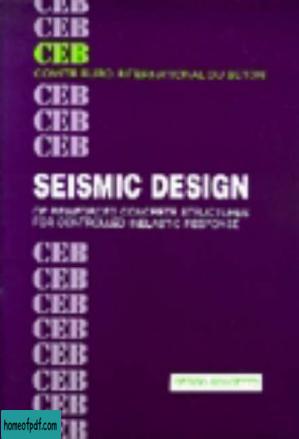Seismic Design of reinforced concrete structures for controlled inelastic response 电子书下载
This detailed guide will enable the reader to understand the relative importance of the numerous parameters involved in seismic design and the relationships between them, as well as the motivations behind the choices adopted by the codes. For a structure to remain elastic under its design seismic action, typically associated with a 10 per cent exceedance probability in 50 years, it has to be designed for lateral forces with magnitude in the order of 50 per cent or more of its weight. Although technically feasible, designing a structure to respond elastically to its design seismic action is economically prohibitive. It is also completely unnecessary, as the earthquake is a dynamic action, representing for a structure a certain total energy input and a demand to tolerate a certain level of displacement and deformation, but not a demand to withstand specific forces.Therefore, seismic design codes allow the development of significant inelastic response under the design seismic action, provided that the magnitude of inelastic deformations does not endanger the integrity of the individual members and of the structure as a whole. The rapid development which has occurred in seismic codes has left a need to review the theoretical framework underlying the process of modern seismic design of reinforced concrete, if for no other reason than to make it more accessible and to explain its logic to those outside the small circle of experts. This design guide aims to satisfy this need in a pragmatic way. This book begins by outlining, comparing and contrasting the approaches taken by four regional codes (New Zealand, USA, Europe and Japan). Next follows a chapter on reliability-based system analysis which demonstrates that the problem of seismic design can be theoretically formulated in a comprehensive way which can provide results of practical value. The main part of the guide is devoted to practical issues relating to the measurement of seismic performance and case reports. The detailed discussions provided will enable the interested reader to understand the relative importance of the numerous parameters involved in seismic design and the relationships between them, as well as the motivations behind the choices adopted by the codes. The final chapter on the assessment of existing buildings covers a crucial topic for the future of earthquake engineering.
尊敬的读者:
欢迎您访问我们的网站。本站的初衷是为大家提供一个共享学习资料、交换知识的平台。每位用户都可以将文件上传至网盘并分享。
然而,随着用户上传的资料增多,我们发现部分不宜或版权问题的书籍被分享到了本站。
为此,我们已经关闭了分享入口,并进行了多次书籍审查,但仍有部分内容未能彻底审查到位。
在此,我们恳请广大读者与我们共同监督,如发现任何不宜内容,请 点击此处 进行举报,我们会第一时间处理并下架相关内容。
希望我们能共建一个文明社区!感谢您的理解与支持!
猜你喜欢
- 《阳光劫匪》[日] 伊坂幸太郎 电子书下载
- Effective Unit Testing - Lasse Koskela 电子书下载
- 《我为什么看不懂你》李海峰/彭洁 电子书下载
- Python for Geospatial Data Analysis - Bonny P. McClain 电子书下载
- 《惊悚乐园》三天两觉 电子书下载
- 《远山淡影》石黑一雄文字版 电子书下载
- 《股票投资的24堂必修课》威廉·欧奈尔全译珍藏版 电子书下载
- 《1793》尼可拉斯·纳欧达格 电子书下载
- 《17年的轮回》杰卿 电子书下载
- [英文][纽约客]new_yorker.2024.09.16 电子书下载
- 《医本正经》懒兔子文字版 电子书下载
- 《木偶奇遇记》卡洛·科洛迪 电子书下载












